Tezpur
| Tezpur | |
|---|---|
| City | |
.jpg) Sunset at Ganesh Ghat near the Brahmaputra, Tezpur | |
| Nickname(s): City of Eternal Romance | |
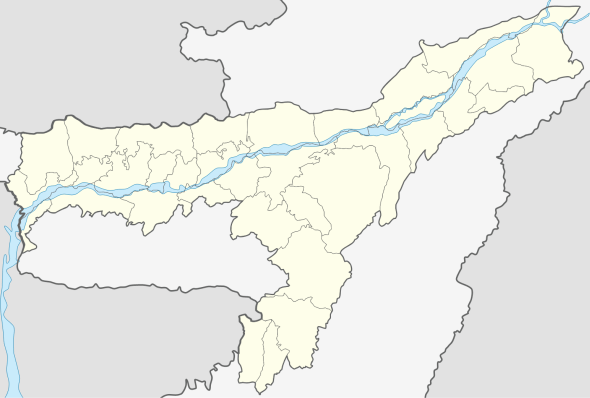 Tezpur Location in Assam, India  Tezpur Tezpur (India) | |
| Coordinates: 26°38′N 92°48′E / 26.63°N 92.8°ECoordinates: 26°38′N 92°48′E / 26.63°N 92.8°E | |
| Country |
|
| State | Assam |
| District | Sonitpur |
| Government | |
| • Type | Municipality |
| • Body | Tezpur Municipality Board |
| Area | |
| • Total | 40 km2 (20 sq mi) |
| Area rank | 5th |
| Elevation | 48 m (157 ft) |
| Population (2011)[1] | |
| • Total | 102,505 |
| • Density | 2,600/km2 (6,600/sq mi) |
| Languages | |
| • Official | Assamese |
| Time zone | UTC+5:30 (IST) |
| ISO 3166 code | IN-AS |
| Vehicle registration | AS-12 |
| Website |
sonitpur |
Tezpur (/tɛzˈpʊər/) (Assamese: তেজপুৰ tezpur, Assamese pronunciation: [tɛspuɹ]) is a city and urban agglomeration in Sonitpur district, Assam state, India. Tezpur is on the banks of the river Brahmaputra, 175 kilometres (109 mi) northeast of Guwahati, and is the largest of the north bank towns with a population exceeding 100,000 as per Metropolitan Census 2011[2].
History
Etymology
The name Tezpur literally means the "city of blood". Legend has it that the original name of this place was 'Xonitpur' ('Xonit' means blood). When the battle between Krishna's army and Lord Shiva, his disciple Banasura's army fought for the rescue of Aniruddha (who was the grandson of Lord Krishna, according to legend) there was so much bloodshed that the place was stained red. This led to the name of the place becoming Tezpur. The Shiva temples in and around Tezpur shows the love and devotions of King Baanasur for Lord Shiva.
Banasura was the eldest of the hundred sons of Bali, who in turn was the son of Virochana and grandson of Prahlada (son of Hiranyakashipu and devotee of Narasimha). Banas mother was Vindhyavali. Bana, the king of demons (asuras), ruled over Sonita-pura. The word 'bana' also means an arrow. He went to the Himalayan regions and performed a penance invoking Shiva's favour. When Shiva appeared in answer to his austerities, Bana begged the god to bestow a thousand arms carrying a multitude of weapons to destroy his enemies and opponents. He also desired that Parvati should consider him as her son. Bana was a great devotee of Shiva and there are several famous self manifest bana-lingas being worshipped in India. Banasura was a powerful and terrible asura. All people, the king of earth, and Devas of heaven were afraid of him. Bana was a follower of Siva. Banasura ruled in present-day central Assam with his capital at Sonitpur (present-day Tezpur). Banasura's wife's was Kandala. Banasura had a beautiful daughter named Usha. Usha one day saw a young man in her dream and fell in love with him. He was Aniruddha, the grandson of Lord Krishna. There was a war between Banasura and Krishna in which Banasura was defeated. Krishna married Usha with Aniruddha and brought them to dwaraka. Banasura moved to Himalayas and devoted his life in worship of Shiva. Xunitpur ( Tezpur) Historical ruins from the 8th and 9th centuries dot the surrounding areas. Resemble Gupta period art. The ruins of Da Parbatia are an example of the architecture around the 6th century AD. Tezpur is considered to be the capital of Assamese culture. Notable residents include Dr. Bhupen Hazarika, Jyoti Prasad Agarwala (1903–51), Kalaguru Bishnu Prasad Rabha (1909–69), and Phani Sarma (1909–70), were from Tezpur. Modern Tezpur was founded by the British colonial administration in 1835 as the headquarters of Darrang district. During World War II, Tezpur received large numbers of refugees fleeing from Burma, particularly the corps of Anglo-Burmese and Anglo-Indian nurses.
Medieval era
Historical ruins from the 8th and 9th centuries dot the surrounding areas. The ruins of Bamuni Hills are the most famous. They resemble Gupta period art. Accordingly, there are plenty of myths as well. The ruins of Da Parbatia are an example of the architecture around the 6th century AD. The people of Deori community believe that their ancestors originally lived in the Sotai hills which are situated north of Tezpur near the borders of Sonitpur district and East Kameng district of Arunachal Pradesh.
Places to see
The historically rich city bears magnificent relics from its past. Although now urbanised, most of the places worth seeing in[3] and around Tezpur speak of its history. Be it the famed Mahabhairav Temple [4], Bhairabi Temple (Maithan)[5], the man-made hill of Agnigarh[6] or the naturally rich outskirts of Nameri National Park[7] and Bhalukpong, the place is thronged by visitors almost all year long.
Connecting the city to the district of Nagaon is another majestic structure, the Kaliabhomora Bridge[8] .
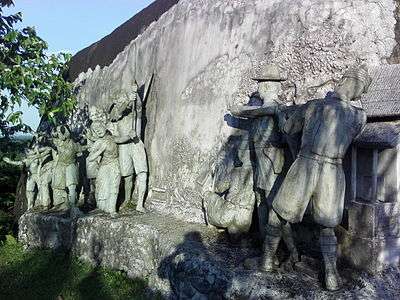
British Raj
Modern Tezpur was founded by the British colonial administration in 1835 as the headquarters of Darrang district. During World War II, Tezpur received large numbers of refugees fleeing from Burma, particularly the corps of Anglo-Burmese and Anglo-Indian nurses. After the independence of India in 1947, it remained the headquarters of Darrang district. During the Sino-Indian War of 1962 the Chinese army advanced to the Tawang city, Arunachal Pradesh. The town was evacuated. The jails were opened and the prisoners released.
Rock inscriptions: In 1897, Sir Edward Albert Gait discovered a copper inscription in Tezpur the deciphering of which provided information regarding the Ahom rulers. He referenced the nine line inscription of Harjjar Varma in 'A History of Assam'. The inscription, dating to 829 A.D., is the first historical record of Assam. The inscription was found engraved on a massive stone some 2 kilometres (1.2 mi) from Tezpur town near Rudrapad Temple.
Hazara Pukhuri: A king of the dynasty Harjjar Varma excavated a large pond in 70 acres (280,000 m2) of land, later came to be known as Hajara Pukhuri (Harjjara Pukhuri).
Christian cemetery: The cemetery dates to the 17th century. It contains the grave of Alexander Bruce, founder of the tea industry in India, and of Europeans who died here before independence.
The first electric power station in this part of India was established at Tezpur by the British in 1913.
Jonaki: The first cinema hall of Northeast India was established by Jyoti Prasad Agarwala in 1935.
Chitraban: The first film studio of Northeast India was established by Jyoti Prasad Agarwala in 1934.
The twin lakes Bor Pukhuri and the Padum Pukhuri in the heart of the city memorialize King Bana and his daughter Usha.
Post-independence
In 1983 a part of the district was carved out to form a separate district, Darrang. Tezpur was made the headquarters of the new district of Sonitpur. There is also a Statue In Memory of Unidentified Soldiers who laid their lives in N.E.F.A. defending our Motherland. Their ASHES immersed with full Military Honours in the River Brahmaputra at TEZPUR on 18 November 1963. Diganta kumar bhuyan: diganta kumar bhuyan is an Assamese from Tezpur,Sonitpur District of Assam.He is Script Writer,Director,Drama music Director & Actor. He is also the executive member of Baan Theatre,Tezpur.
Geography
The town is on the north bank of the Brahmaputra River.
The rivers in and around Tezpur are fast flowing, especially from the Himalayas foothills. Tezpur has a number of small hillocks, so that flooding doesn't occur during the monsoons.
Climate
The average temperature in summer is around 36 °C (97 °F) while the average winter temperature is around 13 °C (55 °F).[9]
Culture
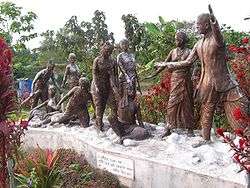
.jpg)
Tezpur is considered to be the capital of Assamese culture. Being from the core Assamese cultural region, notable residents include Dr. Bhupen Hazarika, Jyoti Prasad Agarwala (1903–51), Kalaguru Bishnu Prasad Rabha (1909–69), and Phani Sarma (1909–70), were from Tezpur. Baan Stage was the theatre where they first performed. Nikamul Satra is at Mazgaon, a center of Vaishnavaite culture.
At Dadhara there is Jyoti-Bishnu khelpathar. The fields are used for cultural events.
Demography
The population is largely heterogeneous. Indigenous Assamese communities like Koch Rajbongshi, Keot(Kaibarta), Bodo, Sonowal–Kachari, Sarania–Kachari, Thengal–Kachari, Rabha, Mishing(Miri), Karbi(Mikir), Dimasa, Tiwa, Deori, Assamese Brahmins, Kalita, Nath, Assamese Kayastha, Ahoms, Moran and Motok, Doms/Nadiyals, Assamese Muslims, Assamese Sikhs[10] and Assamese Christians, along with immigrant communities like Nepali communities (form the majority), Bengali, Bihari, Marwari community.
People from the tea-tribes (brought in by the colonial planters as indentured labourers from the Chhotanagpur plateau region) have also made it their home.
Orphanage
- Naba Prabhat Naba Prabhat is an Orphanage founded on 3 February 2006 by Bidyut Saikia. The Orphanage is situated at Ketekibari near Ketekeswar Devalaya. Many visitors from the local and from other districts of Assam visits the orphanage for the celebration of happy moments with the orphan kids of Naba Prabhat.The Founder of this Orphanage died on 30th September 2011.
Religion
The majority of the people in the urban areas are of Hindu faith although a small number of Jains Sikhs and Muslim are also found.In the rural areas the people adhere to a reformed form of Hinduism known as neo-vaishnavite movement founded in 1500s by the Assamese reformer Srimanta Sankardeva.
Local dances
- Bihu dance is an indigenous group dance of the indigenous Assamese community where males and females dance together.
- Bagurumba is another indigenous folk dance of the Bodo community (a part of the indigenous Assamese community).
Local areas/sites of interest
- Agnigarh - Also Usha-Aniruddha Udyan
- Bhairabi Temple - Durga shrine also known as Maithan or Bhairabi Devalaya
- Hanuman Mandir - temple of hanuman near the Bhairabi Temple

- Cole Park - Also known as Chitralekha Udyan
- Kolia Bhomora Setu - The 3.015 kilometres (1.873 mi) long road bridge across the Brahmaputra
- Ketakeshwar Dewal - Shiva shrine
- Mahabhairav Temple - Shiva shrine
- Padum Pukhuri - Central lake with an island in the middle
- Rudrapath - Shiva shrine
- Bamuni Pahar
- Da Parbatia Gate of Gupta period
- Hazara pukhuri- Pond of gupta period.It was dug in the name of great king Hazar-barman.
- Nag Shankar- Temple of lord Shiva
- Kanaklata Udyan
- Ganesh Ghat temple - (For the temple as well the beautiful sunset of the Brahmaputra)
- Garh Doul - An archaeological site situated at Tarajan Kumargaon, Tezpur.
- Jyoti Bharati - (Poki) The First Concrete House in Assam made by Haribilash Agarwalla. Assamese Culture and the Baan Theatre, Darrang College, Mahila Samiti etc. and much more organizing committee was formed in Poki. In Poki various society and group of individuals involved in the persistent social interaction, or a large social group sharing the same geographical or social territory, typically subject to the same political authority and dominant cultural expectations. It was handed over the Government of Assam at the time of Hon'ble Cultural Minister Late. Hiteswar Saikia. Haribilash Agarwalla built the Jyoti Bharati (Poki) in 1874. He was a Tea Farmer by profession and a religious belief person. It was built in the style of Ahom Dynasty buildings.To build this building Haribilash Agarwala has brought many equipment from various part of India.
- Dr. Bhupen Hazarika Kala Academy - It is Cultural Music School situtaed at Pithakhuwa, Tezpur.
- Dak Bunglow - It is situated at the heart of the Tezpur City which was established in 1881.
- District Museum - The District Museum was firstly established in 1986 near Darrang College Road and after 1997 it was permanently situated near Duk Bunglow at Tezpur town area.
Economy
The economy of Tezpur is dependent on its tea gardens. There are many tea gardens surrounding the town. The gardens and agriculture contribute to the local economy. The Zone III of the Assam Branch Indian Tea Association(ABITA) is located at Tezpur. Tezpur has manufacturing plants of FMCG brand Dabur and Patanjali's mega food park is under construction.
Presently Tezpur is a commercial, administrative and educational center. It also houses a major base of the Indian Army and Airforce (Salonibari), I.T.B.P, Bihaguri.
Government sector
Tezpur is part of Tezpur (Lok Sabha constituency).[11]
Media and communications sector
Assamese newspaper Dainik Agradoot is published from Tezpur along with Guwahati and Jorhat.
All India Radio has a local station in Tezpur which transmits programs of mass interest.
Bhattacharya Press It was established in Tezpur on 1936.station in
Transport sector
Tezpur is connected to the rest of the country by road, rail, and air.
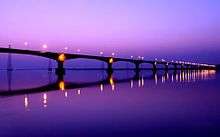
In 1987 the Kolia Bhomora Setu, over the Brahmaputra, was inaugurated connecting Tezpur to the southern district of Nagaon. The bridge in itself has become a tourist attraction. Dekargaon railway station is the nearest railway station of Tezpur which is about 10 km away from the town. The airport is located at Salonibari, 10 km from the heart of the city but is less operated and connects to very few Indian cities which include state capital Guwahati and Kolkata. Tezpur has daily direct flights to Kolkata and the service is provided by zoom airlines.[12]
Education and research sector
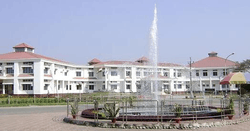
- Central University
- Engineering Institute
- Girijananda Chowdhury Institute of Management and Technology, Tezpur
- Tezpur University, School of Engineering
- Medical
- Lokopriya Gopinath Bordoloi Regional Institute of Mental Health
- Tezpur Medical College
- Research Institute
- Tezpur University
- North Eastern Regional Institute of Water and Land Management
- Defence Research Laboratory
- Department of Electronic Accreditation Computer Course
- Indian Statistical Institute, North East Centre
- Jyoti Kola Kendra (Music/Dance/Art)
- General colleges
- Darrang College
- L.G.B. Girls College
- Tezpur College
- Tezpur Law College
- St. Xavier's College, Ghoramari
- CBSE affiliated schools
- Air Force School, Tezpur
- Army School
- Kendriya Vidyalaya, Central University Tezpur
- Kendriya Vidyalaya#1
- Kendriya Vidyalaya#2
- St. Marys School, Tezpur
- Tezpur Gurukul, Chatai Chaport
- Gyan Bharati school, B.P Tinali
- ICSE Affiliated School
- Assam Valley School
- SEBA affiliated School
- Tezpur Academy
- Sacred Heart School
- Tezpur Collegiate School
- Tezpur Govt.Boys School
- Lokapriya Amiya Kumar Das School
- Silver Jubilee School
- Bengali Boys School
- Sankardev Sishu Niketan
- Rashtravasha Vidyalaya
Medical Treatment Centre
- Baptist Mission Hospital which was founded at Mission Chariali in 1954 .
Notable people
- Nipon Goswami- Assamese actor
- Hem Barua - Assamese poet and politician from Assam
- Bishnu Prasad Rabha - Communist political figure
- Jyoti Prasad Agarwala
- Phani Sarma
- Charles Alexander Bruce
- Bhupen Deka- Freedom Fighter
- Gojen Baruah- An Assamese Writer, Artist, and Actor
See also
References
- ↑ http://www.censusindia.gov.in/pca/SearchDetails.aspx?Id=306544
- ↑ "Tezpur Metropolitan Urban Region Population 2011 Census". www.census2011.co.in. Retrieved 2018-10-08.
- ↑ "Tezpur City of Assam - Tourist Spots and Historical Significance of Tezpur". www.assamjournal.com. Retrieved 2018-10-08.
- ↑ "Mahabhairav Temple", Wikipedia, 2018-07-25, retrieved 2018-10-08
- ↑ "Bhairabi Temple", Wikipedia, 2018-07-20, retrieved 2018-10-08
- ↑ "Agnigarh", Wikipedia, 2018-08-07, retrieved 2018-10-08
- ↑ "Nameri National Park", Wikipedia, 2018-07-20, retrieved 2018-10-08
- ↑ "Kolia Bhomora Setu", Wikipedia, 2018-08-12, retrieved 2018-10-08
- ↑ "Tezpur, India Weather Averages - Monthly Average High and Low Temperature - Average Precipitation and Rainfall days - World Weather Online". Retrieved 2 February 2015.
- ↑ "Meet the Axomiya Sikhs". The Tribune. Chandigarh. 24 March 2013.
- ↑ "List of Parliamentary & Assembly Constituencies" (PDF). Assam. Election Commission of India. Archived from the original (PDF) on 2006-05-04. Retrieved 2008-10-06.
- ↑ "Kolia Bhomora". Akash Pratim Baruah's website. Archived from the original on October 26, 2009. Retrieved 5 May 2007.
External links
| Wikimedia Commons has media related to Tezpur. |